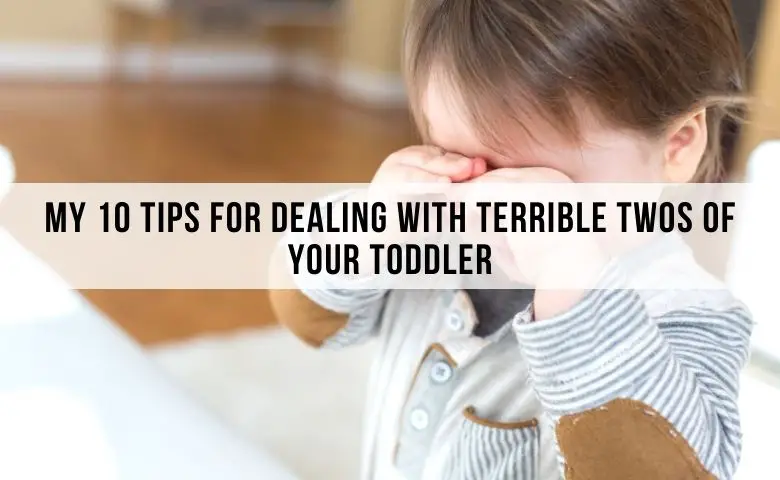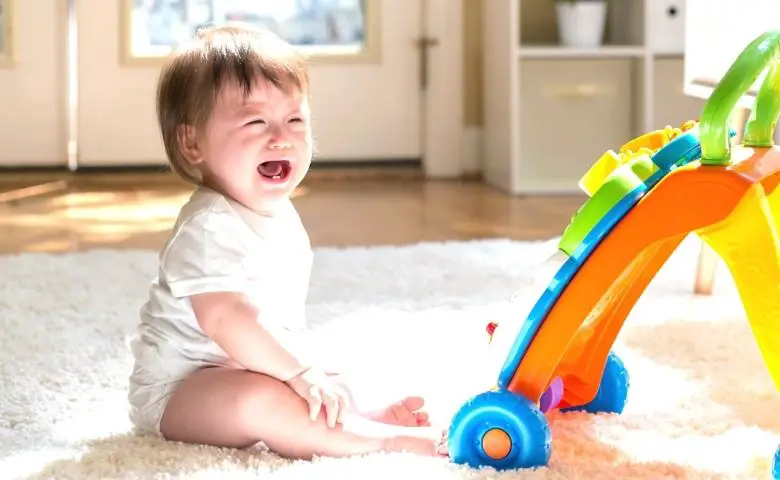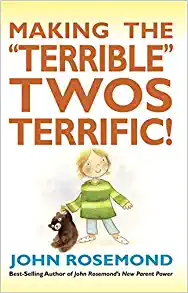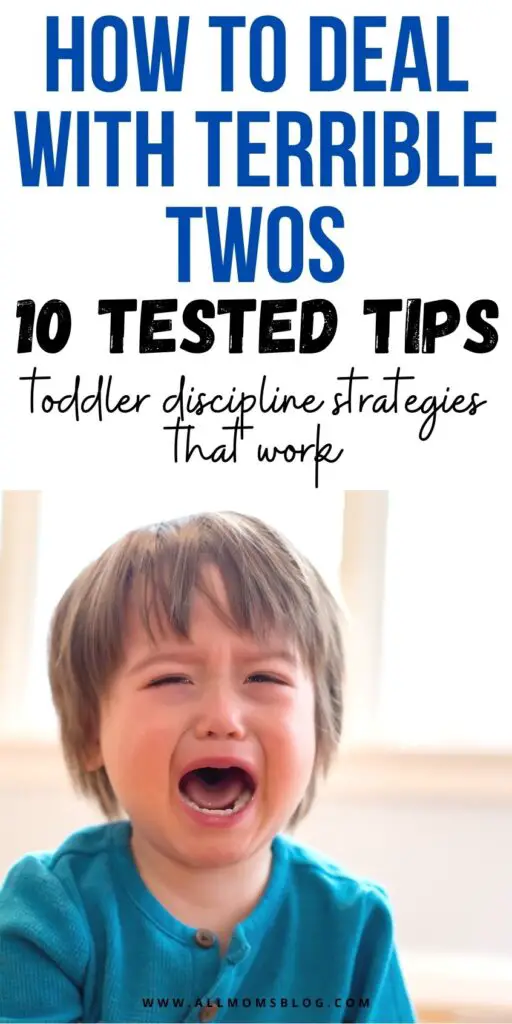Did you think the terrible twos was just a myth?
Your toddler has just become two years old, and the terrible twos have just begun. I have some bad news. Don’t think that this will go away once your child turns three. If you do not take certain steps, you may be facing a problem in the future.

The “Terrible Twos” is really an unfortunate term. It tends to set parents up to be apprehensive about their two-year-old, and it also may cause parents to worry unnecessarily when “Terrible Twos” behavior manifests when their child is three, four, or five years old.
Regardless of the age, there are some strategies out there for keeping that kind of behavior – temper tantrums, screaming, etc. – from becoming completely out of control.
Keep reading on if you want to know the tricks for dealing with terrible twos, and how to turn the second year of your baby’s life into a year filled with happiness and beautiful memories. It is possible to achieve, and it is actually easy!
In this post, the following will be discussed.
- Terrible Twos Symptoms
- Terrible Twos Psychology
- Tips for Dealing With Terrible Twos
- What is normal terrible twos behavior?
- When do terrible twos end?
Disclaimer: I am not a doctor. This post is for educational purposes only, and it should not be taken as medical advice. If you have any concerns about your child’s behavior, talk to your child’s doctor.
Why is it called terrible twos?
Terrible twos meaning is “Terrible twos” has long been used to describe the different types of changes that parents observe in their 2-year-old children.
Parents often perceive this period of their toddler’s life as terrible because of the rapid change in their child’s mood and behaviors. It often gets very difficult to deal with them.
What are the symtoms of Terrible Twos?
The terrible twos is a hard period for the parents and harder for the child experiencing it. During this period, a child’s behavior changes.
The child might cry more, may not want to listen, and may want to do everything on their own. Terrible twos age range is 2 and 3 years, but it could begin as early as one year old.
Some terrible twos symptoms include:
- Hitting
- Biting
- Saying No A Lot
- Not Wanting To Follow Rules
- Getting Frustrated Very Easily
- More Than Normal Tantrums
- Fighting With Peers
- Not Wanting To Share
- Throwing Toys & Objects
- Wanting Independence
Terrible Twos Psychology
The terrible twos can begin between the age of 1 and progress to the age of 3. This is the time when children begin to understand they can do things on their own.
The want of independence and the frustration of not being able to do something alone causes the behaviors that characterize the terrible twos.
Children at this age understand what is going around them, but they may not be able to communicate their wants and needs because of their limited vocabulary. This can cause a huge amount of frustration which can lead to meltdowns, tantrums, and other characteristics of the terrible twos.

The tantrums and defiant behavior your child might be having is probably just his way of saying I want to do this or I do not know how to do this. You need to stay calm and learn the different ways to help your child navigate through this time.
Remember a child is always watching you, and he/she learns from you. Keep reading to learn the tips for dealing with terrible twos.
Does Terrible Twos affect sleep?
While it’s common for young children to wake up at night, once the children enter the stage of terrible twos, they are less likely to wake up in the middle of the night and start to sleep through.
If you find your toddler waking up at night there can be many other possibilities other than just terrible twos.
However, here are some of the most common terrible twos sleeping problems that may be the reason for your toddler waking up in the middle of the night:
- Nightmares: It’s usually unlikely for children to experiece bad dream causing them to wake up screaming. But most children start having nightmares during the toddler years.
- Night terrors: Night terrors occur when your child start talking or screaming in their sleep. Althought this happens when the children are around 3 years or odler, but it can happen earlier as well.
- Overheating or night sweats: Young kids bodies are not fully developed and this inculdes their body temperature. Young children are mostly prone to night sweats (feeling hot or sweating excessively).
- Allergies: Just like us, chidlren can be allergic to pollen, dust mites and other environemental allergens. If your child wakes up with dry, itchy eyes or runny nose or cough, this could be the reason.
If you notice your child is showing these symptoms, it is better to take him/her to the doctor to figure out any underlying issues. Once you have done that, you can move on to other home advice you can follow for a better night’s sleep for everyone.
Tips for Dealing With Terrible Twos
There are a few tips for dealing with terrible twos. I have personally used these tips, and they have worked very well with me.
For your question How to deal with the terrible twos, here are the tips for dealing with terrible twos.
When your child is having a meltdown or a tantrum, try to distract him/her.
Bring up something exciting or something your child is interested in. I personally used to keep a new toy car in my purse when we went out to distract my son quickly in public.
At home, I used to take him out to the patio for fresh air. He loved going outside so it was a great quick distraction for him. A distraction could be even simpler.
For example, you could literally just stop talking, hug your child and just play a very calming song like hush little baby on your phone. This also works well with my son. Just remember if you use the song technique, it is important for you to not say a word even if your child is still screaming. He/she will eventually calm down.
Always Stay Calm
I know it is hard sometimes to stay calm, but it is very important. Do not yell or show anger when your child does something wrong. Children learn from their parents.
If you yell, your child will learn that when he/she is angry, he/she should yell. Explain to them what they are doing wrong, and then redirect them or distract them.
Here’s how to get your children to listen to you without yelling!
Make sure they understand that certain behaviors are unacceptable.
Set Rules and Stay Consistent
This is a very important step. If you do not want the terrible twos to continue forever, set rules and stay consistent. Do not yell. Just explain to them in simple words that they should do something for this reason.
For example, if you tell them to clean their room. Do not begin another task until they have finished cleaning their room. Then, make it a routine. After they play, they should always clean their room.
Here’s a list of age-appropriate chores for your children to help you around the house.
Make rules simple and if they do not follow them, set consequences. For example, I tell my son if you want to go to the store with me, you can only pick one item for yourself and you have to give it to the cashier without crying.
For the first few times, he used to pick one item, but then he wouldn’t give it to the cashier.
He would throw himself on the floor and yell. So, I told him you will not get this item because you screamed, and I asked my partner to take him out of the store so I could pay.
After a few times, he understood and stopped yelling.
Play With Your Child
Play with your child every day. It is important to create a connection between you and your child.
Also, your child develops emotionally, academically, and physically through play. So, make sure to spend time with them. Any game played with your child will help in his/her growth.
Tantrums may be caused by boredom or lack of attention. Through play, tantrums can be avoided. Understand what causes your child to have tantrums and try to avoid them.
Sometimes Your Child Needs A Break
I personally do not like timeouts. Instead, I tell my child you need a break when the negative behavior won’t stop. Your child might be so overwhelmed, and the only way he is portraying this is through negative behavior.
Instead of giving him a timeout which is something negative, give him a break. I fill up a basket with calming toys and materials. Some items found in my break basket are a bottle filled with water and glitter, a busy book, teddy bears, an hourglass, and noise-canceling headphones.
My son loves it, and it automatically changes his mood from negative to positive. It gives me some time to relax too. After a few minutes, I go up to him and explain to him that his behavior was not acceptable and that I understand he may be overwhelmed.
Sometimes You Need A Break
Children can feel everything going around them. If you are a mom, you will get overwhelmed. Being overwhelmed when around children are very normal. You need time for self-care and to relax especially on days you may be facing monthly female problems. If you are upset or irritated, your child will sense that and may become emotional.
Let Them Know You’re Bigger
This is not to say that you need to intimidate your toddler. Instead, let her know you are big enough to “take it.” When your toddler acts up, she may be looking for a reaction from you to see if her behavior is appropriate or if it gets results.
If you do not let their behavior make you react strongly, it may curtail the tantrum.
Loving Response
It’s tempting to want to respond angrily to your toddler’s behavior.
But you might try something unexpected that is recommended by some child development experts and counselors: help your toddler calm down by putting your arms around her, letting her know that you know her feelings are really big but that you are bigger, and can help her manage those feelings.
You are physically restraining her, but in a loving way that says you are there to help her control herself, not just “hold her down.”
Tame Your Own Temper
It’s a good idea not to have a temper tantrum of your own. If you “lose it” when your child is losing it, then all is lost! The two tantrums tend to feed off of each other and make the situation so much worse.
Also, consider your behavior during the times when your toddler is calm – are you modeling anger and tantrum-like behavior as a way to handle frustrations in life?
For example, if you tend to have angry outbursts, your toddler will see this behavior and may adopt it as his own.
Set Routines
Knowing what to expect can go a long way in keeping toddler behavior calm. Making transitions smooth – “Five more minutes until we leave the park…three more minutes…okay, one more minute…” – can also help toddlers have time to adjust to upcoming change inactivity, which tends to decrease potential frustration.
Some little ones find a timer helpful as a visual and auditory reminder of the passage of time and the upcoming change.
Daily routines help toddlers feel secure, too – they don’t have to be so worried and upset about what is coming next.
What is normal terrible twos behavior?
It is very normal for your child to be showing the symptoms of the terrible twos. It actually means your child is developing normally.
However, they are a few behavior issues you need to look out for that may signal something bigger.
Some of these behaviors include:
- Several tantrums a day.
- Tantrums that last longer than usual.
- Tantrums that are caused by no known cause.
- Extreme aggressive behavior that may include hurting oneself.
If your child is showing these behaviors, please contact your child’s doctor.
How long do terrible to last?
There is no one answer to this question. Some children overcome these behaviors very quickly, while others keep them until they are nine years old.

Following the tips for dealing with the terrible twos is very important. Those tips can help you and your child overcome this phase of life very quickly.
Terrible two books
There are a few handfuls of terrible twos books that you can read as a guide to help you navigate through this stage of your toddler’s life with ease.
Making the “Terrible” Twos Terrific!

The Terrible Two (Series from 1 – 4)

In Conclusion: Dealing With Terrible Twos
Remember, your child’s behavior is a reflection of what he sees and how he feels. It is easy to change negative behaviors. You just need to be firm and stay consistent.
Also, remember to play with your child and create beautiful memories. That is what makes a child happy. Don’t give timeouts; instead, give you and your child a break to relax.
A happy mom and child make a happy family! If you have more tips for dealing with terrible twos, leave a comment below.
Related Articles:
Potty Training Tips For First Time Parents
How To Start Teaching Kids At Home – 8 Homeschooling Basics
Age Appropriate Chores For Kids 1 – 11+ Years
The 8 Most Effective Strategies To Raise Confident Kids
11 Effective Tips To Reverse Defiance In Kids
How To Make Your Child Listen Without Yelling
Don’t Forget to Pin it For Later!

My 10 Tips For Dealing With Terrible Twos – How to deal with terrible twos

Halimeh Salem
Halimeh Salem is a childcare teacher, a freelance writer, and a mother of two beautiful children, Basem
and Sama. She has a BA in English Literature and Translation. To pursue her dreams of helping mothers
overcome the obstacles of motherhood, she founded her own blog, Crying Toddlers. She loves spending
her free time playing with her children and helping others.
